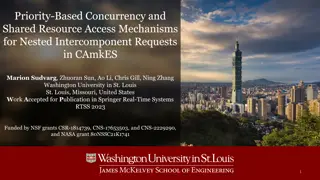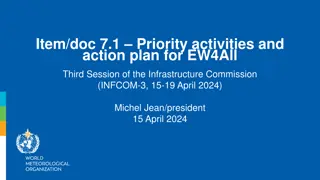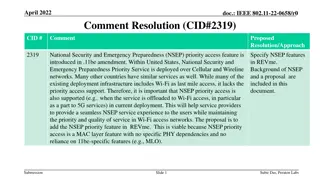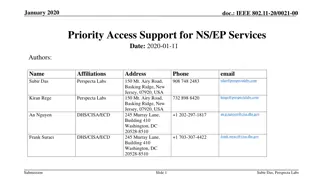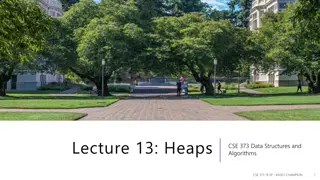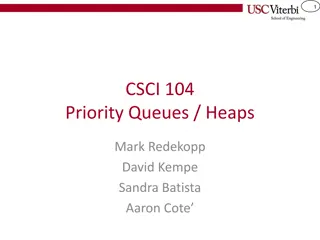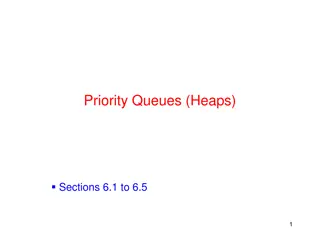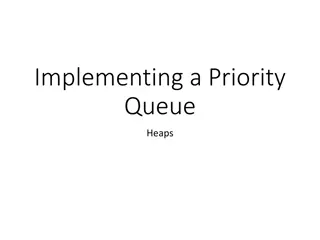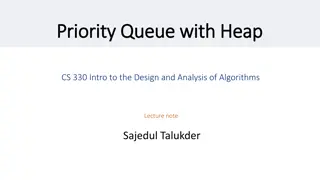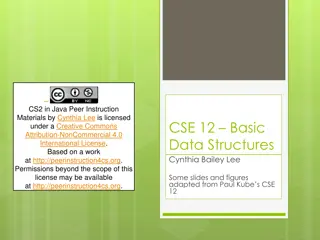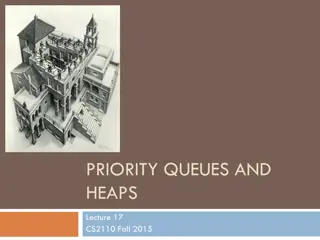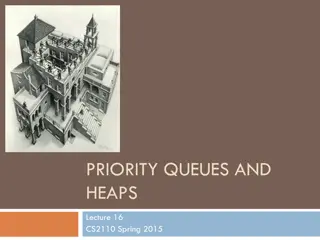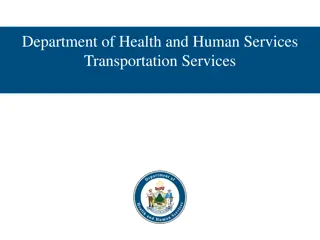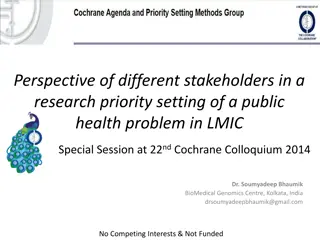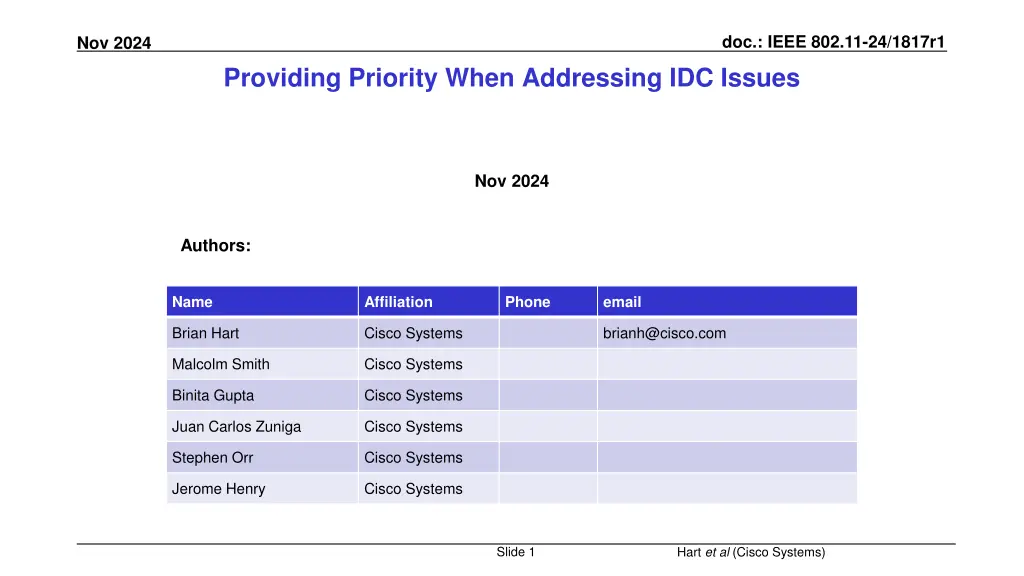
Addressing In-Device Coexistence Challenges in Wi-Fi Networks
Explore the challenges of In-Device Coexistence (IDC) in modern Wi-Fi networks and the need for balanced solutions to prioritize traffic/service based on varying IDC characteristics. Learn about the impacts, constraints, and potential solutions for managing IDC issues effectively while maintaining network performance and efficiency.
Download Presentation

Please find below an Image/Link to download the presentation.
The content on the website is provided AS IS for your information and personal use only. It may not be sold, licensed, or shared on other websites without obtaining consent from the author. If you encounter any issues during the download, it is possible that the publisher has removed the file from their server.
You are allowed to download the files provided on this website for personal or commercial use, subject to the condition that they are used lawfully. All files are the property of their respective owners.
The content on the website is provided AS IS for your information and personal use only. It may not be sold, licensed, or shared on other websites without obtaining consent from the author.
E N D
Presentation Transcript
doc.: IEEE 802.11-24/1817r1 Nov 2024 Providing Priority When Addressing IDC Issues Nov 2024 Authors: Name Affiliation Phone email Brian Hart Cisco Systems brianh@cisco.com Malcolm Smith Cisco Systems Binita Gupta Cisco Systems Juan Carlos Zuniga Cisco Systems Stephen Orr Cisco Systems Jerome Henry Cisco Systems Slide 1 Hart et al (Cisco Systems) -
doc.: IEEE 802.11-24/1817r1 Nov 2024 Problem Statement: IDC happens, but Wi-Fi shouldn t volunteer to become the kick me wireless technology[1] Modern AP and client devices contain multiple radios with in-device coexistence (IDC) requirements TX PSD leakage/spurs affecting other operating channels: For performance, best addressed internally (e.g., RF ASIC design, RF filtering; with costs) Market pressure to externalize those costs via a protocol solution Overlapping operating channels Requires a protocol solution Hence current SFD text: 11bn defines a mechanism for a non-AP STA to report unavailability at TXOP level and define or reuse/update existing mechanism for a non-AP STA to report long term (periodic) unavailability. [Motion #30, [1] and [66-82]] Meanwhile: Solving In-Device Coexistence (IDC) shouldn t come exclusively or predominantly at any one wireless technology s expense Just because a wireless technology is more polite and resilient doesn t mean that the wireless technology should volunteer to be subordinated to less polite and/or more brittle technologies Rather, we should plant the flag, for now and the future, for a balanced proposal, based on traffic/service priority (~expiry imminence) Slide 2 Hart et al (Cisco Systems) -
doc.: IEEE 802.11-24/1817r1 Nov 2024 Many Problem Subvariants according to IDC source, use case and implementation Define Serving link (802.11) and IDC link (802.11 P2P / TDLS, Bluetooth, UWB, cellular etc) Define Serving device (operates serving link only) and IDC device (operates 802.11 link + IDC link) IDC characteristics can create different impacts and constraints: A. Same wireless resources: one or the other service can proceed but not both at the same time E.g., on-channel P2P, or same-channel TDLS B. Nearby wireless resources with unshared device resources: i.e., TX+TX or RX+RX possible but not TX+RX E.g., 802.11 and BT at 2.4 GHz (thru same antenna) RX+RX is low hanging fruit TX+TX quickly leads to NSTR -like coordination requirements (very hard between wireless technologies) C. Different wireless resources with shared device resources: E.g., off-channel 802.11 P2P / TDLS, or a shared 2.4 GHz transceiver with a different passband width, etc When communicating on the IDC link, no resources are available for the serving link and vice versa Corollary: IDC activity, once started, cannot be interrupted IDC link may have: I. Predictable start times [+predictable duration], or II. Unpredictable start times, when TX/RX knowledge is only established a few milliseconds beforehand; also III. Also brittleness: if the start time is missed, no retries-in-time are supported encourage modernization Slide 3 Hart et al (Cisco Systems) -
doc.: IEEE 802.11-24/1817r1 Nov 2024 There is no magic bullet to address all these problems, so we need a tool kit of partial solutions When the serving activity has higher priority, and the IDC device s policy supports it, feasible ways to override/ interrupt the unavailability time for IDC activity: 1. Not possible (IDC has started, with A/BTX+TX/C) 2. If the TXOP of the serving traffic has already started and IDC device does not need to respond (A/BTX+TX/C via IDC deferral; also while BRX+RX) 3. If the TXOP of the serving traffic has already started; and the IDC device is able to respond (A/BTX+TX/C with IDC deferral; also BRX+RX then interrupted IDC) 4. If the IDC device does not need to respond, for any priority of serving traffic (BRX+RX) 5. For serving traffic of higher priority traffic, which may start at any time (BRX+RX then interrupted IDC) Unavailability time for IDC activity, AC_VI Serving device IDC device SFD; 1 BA Serving device IDC device SFD; 1 BA Serving device IDC device 2: AC_VO Serving device IDC device 3: AC_VO BA Serving device IDC device 4: AC_BE Serving device IDC device 4: AC_BE Serving device IDC device 5: AC_VO BA Slide 4 Hart et al (Cisco Systems) -
doc.: IEEE 802.11-24/1817r1 Nov 2024 with protocol support Problem Subvariant I. Periodic II. Aperiodic Tasks for IDC Device EDCA contention according to AC // Priority-based LBT etc for non-802.11 systems Send SCS( QC( ControlInfo(TID, UP), MediumTime) A. Same wireless resources B. Nearby wireless resources + unshared device resources Proposals towards: - Send Initial control frame indicating start of upcoming unavailability [+ duration], and/or - Send Control response frame indicating start of upcoming unavailability [+ duration] // Both missing priority information Proposals towards: - P2P TWT // Missing priority information and negotiation C. Different wireless resources with shared device resources Tasks for Serving Device After the SCS negotiation converges, issue regular TXS, according to priority Proposals towards: - IDC session start+stop. During the session, non-IDC peer starts with an ICF+CRF Data(QoS Control(TID)) is available but is later ICF is better. // Non-IDC Peer s ICF is missing TXOP priority. A. Same wireless resources B. Nearby wireless resources + unshared device resources // Current P2P TWT requirements are missing priority-based arbitration Otherwise, should honor accepted P2P TWT SPs C. Different wireless resources with shared device resources Slide 5 Hart et al (Cisco Systems) -
doc.: IEEE 802.11-24/1817r1 Nov 2024 Two New Parameters need to be Signaling AC / UP / TID to indicate priority of the unavailability activity (e.g., 2-4 bits) Or priority needed to interrupt the unavailability activity Priority values can be mapped to a nominal expiry imminence time, for non-data services such as ranging Interruptibility of IDC activity (e.g., 0-3 bits) 1. Not possible (AC/UP/TID is reserved), or 2. Interruptible when the TXOP of the serving, higher priority traffic has already started and IDC device does not need to respond, or 3. Interruptible when the TXOP of the serving, higher priority traffic has already started. The IDC device is able to respond, or 4. Interruptible when the recipient does not need to respond, for any priority of serving traffic starting at any time (AC/UP/TID is reserved), or 5. Interruptible for serving, higher priority traffic starting at any time, or 6. Interruptible for either 4 or 5. Max compression: no bits are allocated for interruptibility, then AC / UP / TID indicates priority needed to interrupt the unavailability activity at (say) 6 ) but sending highest priority AC / UP / TID means 1 i.e., 2 7 bits; less than 1 octet Slide 6 Hart et al (Cisco Systems) -
doc.: IEEE 802.11-24/1817r1 Nov 2024 To round out the toolset, these parameters need multiple containers ICF sent by IDC device Included alongside new time fields CRF sent by IDC device Included alongside new time fields ICF sent by serving device Depends on which frame is sent: If MU-RTS then Special User Info field++ If BSRP then many choices (and TID is already available) // Also need a mgmt. frame exchange so Serving and IDC devices can negotiate the IDC session start + end Channel Usage Request frame with a Channel Usage element with Usage Mode = 3 (for P2P TWT) Most naturally signaled via a new element Or possibly included via hacking the Channel Usage element e.g., allocate a range of Usage Modes e.g., assign a range of currently unassigned / unassignable values for the (operating class, channel number) // Other concerns related to this protocol will be addressed in a separate presentation Slide 7 Hart et al (Cisco Systems) -
doc.: IEEE 802.11-24/1817r1 Nov 2024 Summary Balanced and informed In-Device Coexistence has strategic value to 802.11 There are many IDC scenarios A. Same wireless resources: one or the other service can proceed but not both at the same time B. Nearby wireless resources with unshared device resources C. Different wireless resources with shared device resources leading to different mitigations: Working around the IDC activity whenever higher priority, or Completing higher-priority serving TXOPs that started before the expected IDC activity During RX+RX, if higher-priority serving TXOPs need to TX for success (e.g., control response), then allow the IDC device to defer / cancel the lower priority IDC activity according to policy The signaling requirements are very modest (< 1 octet) Priority of the IDC activity (or what priority it would take for it to defer or cancel the IDC activity) Under what circumstances the IDC activity can be performed in parallel / deferred / cancelled The signaling requirements can be readily contained in the applicable control and mgmt. frames Slide 8 Hart et al (Cisco Systems) -
doc.: IEEE 802.11-24/1817r1 Nov 2024 SP1 Do you support adding, to the SFD, the following text: The 802.11bn amendment shall define signaling for IDC devices that signal unavailability for their serving link to further signal a) the priority of the unavailability activity and b) under what circumstances, if any, the IDC device is prepared to operate the serving link during the signaled unavailability. Y / N/ A Slide 9 Hart et al (Cisco Systems) -
doc.: IEEE 802.11-24/1817r1 Nov 2024 Backup Slide 10 Hart et al (Cisco Systems) -
doc.: IEEE 802.11-24/1817r1 Nov 2024 References [1] 23/573 Balanced In-Device Coexistence Slide 11 Hart et al (Cisco Systems) -

